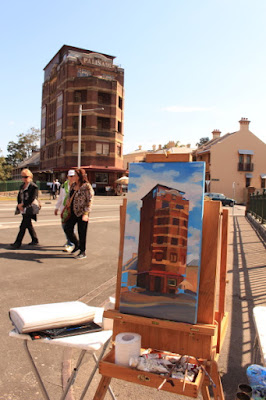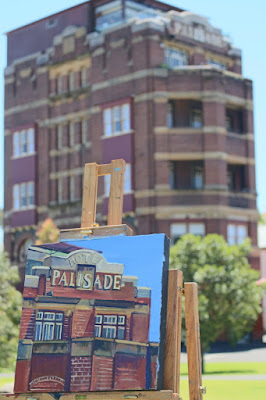 |
MP28 'Darling House' 2014 oil on canvas 51 x 41cm Available for sale |
About Me

- Jane Bennett Artist
- Sydney, NSW, Australia
- I'm an Industrial Heritage Artist who paints "en plein air".If it's damaged, derelict, doomed and about to disappear, I'll be there to paint it.
Saturday 5 December 2015
Darling House, Millers Point- It's not dear it's darling
Saturday 21 November 2015
Hotel Palisade redux
There's just so much history in the walls of the Palisade.
It was the scene of the last drinks for many Anzacs before they left Australia during the First World War, and the 'local' for the engineers and navvies working on the construction of the Sydney Harbour Bridge. Desperate wharfies seeking work at the Hungry Mile during the Great Depression would either drown their sorrows or celebrate their good fortune in finding a day's work, depending on luck. It was the haunt of 'colourful characters', the much loved centre of the Millers Point community and the headquarters of activists during the era of the Green Bans and the Patrick's dispute.
It stood on the corner of Argyle and Bettington streets in Millers Point like an exclamation point at the end of High street. For many years it was the tallest building in Sydney, and overlooked the wharves of East Darling Harbour which provided most of its clientele. At the time of its building, workers terraces to house the wharfies were being constructed in High Street which was carved into the sandstone escarpment above the Fingerwharves and Bond stores below.
This painting shows one of the landbridges over Hickson Road, and the railings preventing revellers falling into the deep cutting in front of the Palisade. This strange configuration of the landscape makes the quirky, slightly ramshackle style of the Palisade even more startling.
In 2014, when I painted this canvas, there was a small park in front of the Palisade. It was overgrown, but its figtrees were a welcome source of shade in summer. Since the redevelopment of this area, the park is now a wide green lawn with a few saplings which will need a lot of time before they provide shade.
MP7A Hotel Palisade 2014
oil on canvas 36 x 46cm
Available
There had been an earlier, much smaller hotel built on this site in the 1880s but it was pulled down in the frenzy of slum clearances at the beginning of the 20th century.
After the end of the bubonic plague crisis in the first decade of the 20th century, the population in Millers Point increased so much that the Sydney Harbour Trust had to build replacement hotels to cater to the port workers. Henry Deane Walsh was commissioned to build the new Palisade Hotel, one of 4 that were built by the Trust, the others being Dumbarton Castle, the 'Big House' (Moretons in Sussex Street- now the Sussex Hotel) and the Harbour View Hotel. 
MP30 The Reopening of the Palisade
2015 oil on canvas 51 x 25cm
Enquiries about similar paintings
The 5 storey hotel was built in 1915-16, and was one of the last Sydney buildings to be designed in the 'Federation Free' style, with parapets, and sandstone banding decorating the red brick masonry.
From the 1920s the head lease for the hotel was owned by Tooth and Co. who sub let it to various licensees.
MP30 The Reopening of the Palisade
2015 oil on canvas 51 x 25cm
Enquiries about similar paintings
From
1936, when the role of the Sydney Harbour Trust was taken over by the
newly formed Maritime Service Board, title to the hotel was issued to
the MSB, although Tooths continued to lease it until 1950. At that time
the licensee, P. K. Armstrong, obtained the lease.
In February 1987 title passed from the MSB into private ownership, then in 1994, Palisade Properties Pty Ltd obtained title.

MP30 The Reopening of the Palisade
2015 oil on canvas 51 x 25cm

MP30 The Reopening of the Palisade
2015 oil on canvas 51 x 25cm
Saturday 26 September 2015
Sign of the Palisade

MP7 Sign of the Palisade 2014
acrylic on canvas 10 x 10cm
Available for sale
 |
| MP39 'Sign of the Palisade' 2014 oil on canvas 31 x 31cm Available for sale |

Monday 15 June 2015
Open House
I jumped the fence and painted some small plein air canvases while it was being demolished.
 |
| "Half demolished apartment block in Cowper Street Glebe/Ultimo" 2011 oil on canvas 15 x 15cm Enquiries |
 |
'Open Plan' -half demolished apartment block
in Cowper Street Glebe/Ultimo" 2011 oil on canvas 13 x 18cm Enquiries
The shell of the 'Mirragang' apartments on the left, and the 'Mirrabooka' on the right, frame the handsome dark brick building in the centre.
This former wool bond store, the Farmers and Graziers No 2 Store, was the last of the great bond stores, and replaced a swath of houses in 1936.
The low-lying swampy area of Glebe and Ultimo has always been known for cheap and often nasty housing.
From the 1850s onwards, a jumble of workshops, slaughter yards, boiling-down works and other scrappy industries sprang up around the noxious waters of Blackwattle Creek. Cramped cottages without water or sewerage, were erected by landlords for the working poor. People lived cheek by jowl with domestic animals. Refuse and offal from the slaughter yards often remained to rot on the mudflats. The abattoirs provided the bones to be burnt in the Char Tower of the CSR Distillery, which were used to filter sugar. And all of the residue was pumped right back into the Blackwattle Creek.
However uninspired these redbrick tower blocks looked, they were a vast improvement on their predecessors. Mind you, that wouldn't have been hard. Almost anything would have been.
|
 |
| 'Open House' - 2011 oil on canvas 25 x 20cm Available Enquiries |
These 15 public housing apartment blocks in Cowper Street, Glebe, were demolished by the state Labor government in 2011, resulting in the eviction of 130 tenants. Although new housing on the site was promised, to be funded by the proceeds of money raised by the sale of 99-year leases to Millers Point terraces, the land was left vacant for years as a development application was lodged and contested in court.
The O'Farrell cabinet approved construction plans for 153 public housing units, 95 affordable housing units and 247 private apartments on the site in 2013.
Tuesday 17 February 2015
Banners, Millers Point
"Dalgety Terrace Millers Point"
2014 oil on canvas 46 x 61cm Collection : Mitchell Library, State Library of NSW Enquiries about similar paintings
The Harbour Control Tower looms ominously over the row of ramshackle terraces on the sandstone block wall of Dalgety Road.
Some of the houses sport protest banners :"Millers Point not 4 sale" "Our community is worth more than money"
Fortunately some of the banners were still there long enough for me to paint them, however, a few weeks afterwards the Housing NSW Millers Point Relocation Team had torn them down.
Housing NSW's Relocation Officers and their security and "cleansing" teams have been removing banners and photos of residents throughout Millers Point. The banners on the Garrison Church Rectory and on St Brigid's Church were removed in January 2015.
"Dalgety Terrace Millers Point"
2014 oil on canvas 46 x 61cm Collection : Mitchell Library, State Library of NSW Enquiries about similar paintings
Luckily I finished painting this canvas just before the roadwork started.
I was set up between 2 of the hideous new apartments built several years ago to replace a set of old Maritime Services Board warehouses.  |
"Dalgety Terrace Millers Point"
2014 oil on canvas 46 x 61cm Collection : Mitchell Library, State Library of NSW Enquiries about similar paintings
To add insult to injury,there is now a serious attempt to remove even the name "Millers Point" from the suburb- see Don't erase Millers Point Facebook Page
This canvas, which I exhibited in my solo exhibition "Under the Hammer" Frances Keevil Gallery 2014, was recently acquired for the collection of the Mitchell Library, State Library of NSW.
My canvases are banners that can never be torn down.
|
Monday 8 December 2014
On location - A Short film of my paintings
Short film of "Under the Hammer"
While I was painting some tiny quick studies of terrace houses in Argyle Place in October-November 2014, I was filmed by Lachlan Bennett (no relation!). In the film, I speak about industrial heritage, the de-industrialisation of the city and my latest solo exhibition, 'Under
the Hammer'.
It's impossible to convey the same sense of wonder and beauty that I experience while painting on location, but it's worth a try.
.JPG) |
| "36 Argyle Place" 2014 oil on canvas 15 x 10cm Available Enquiries : janecooperbennett@gmail.com |
Saturday 30 August 2014
Stairway to Nowhere
The three bridges which carry Argyle, Munn and Windmill Streets over Hickson Road are rare examples of Monier Arch bridges. They were constructed along with the cuttings and other civil works in the area between 1910 and 1914 as part of the redevelopment of Walsh Bay by the Sydney Harbour Trust. For the time, they were controversial & cutting edge technology as they were some of the earliest bridges to be built in Sydney using a new material called ferro-concrete (now known as reinforced concrete).
Yesterday, upon the stair,
I met a man who wasn't there
He wasn't there again today
I wish, I wish he'd go away...
When I came home last night at three
The man was waiting there for me
But when I looked around the hall
I couldn't see him there at all!
Go away, go away, don't you come back any more!
Go away, go away, and please don't slam the door... (slam!)
Last night I saw upon the stair
A little man who wasn't there
He wasn't there again today
Oh, how I wish he'd go away...
Sunday 6 April 2014
Another one bites the dust
.JPG) |
Tuesday 1st April about 11am
"Harbour Control Tower and Barangaroo from High Street, Millers Point" 2014 oil on canvas 61 x 183cm
Enquiries about this painting :
|
 |
Wednesday 2nd April about 11am
"Harbour Control Tower and Barangaroo from High Street, Millers Point" 2014 oil on canvas 61 x 183cm
Enquiries about this painting :
|
 |
'Evening Harbour Control Tower from Moore's Wharf' 2013 oil on canvas 178 x 122cm |
 |
'The Shipping News - Last view of interior of Harbour Control Tower ' 2011 oil on canvas 25 x 51cm
Enquiries about this painting : |





.JPG)